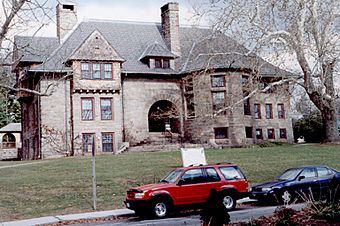Peace Dale, Rhode Island facts for kids
Quick facts for kids |
|
|
Peace Dale Historic District
|
|

Peace Dale Library
|
|
| Location | South Kingstown, Rhode Island |
|---|---|
| Architect | Frank W. Angell; Et al. |
| Architectural style | Colonial Revival, Late Victorian, Romanesque |
| NRHP reference No. | 87000493 |
| Added to NRHP | October 30, 1987 |
Peace Dale (sometimes spelled Peacedale) is a small village in South Kingstown, Rhode Island. It's part of a larger area called Wakefield-Peacedale, which is recognized by the U.S. Census.
The Peace Dale Historic District was added to the National Register of Historic Places in 1987. This means it's a special area with old buildings and places that are important to history. The district covers the main part of the village, including streets like Kersey Road, Kingstown Road, and School Street.
Contents
History of Peace Dale
Peace Dale was started in 1793 by a man named Rowland Hazard. He was an industrialist, meaning he owned and managed factories. He named the village after his wife, Mary Peace Hazard.
Early Mills and Inventions
Around 1804, Rowland Hazard was one of the first people in Rhode Island to use special machines called carding machines. These machines helped prepare wool for making cloth. In 1814, he also used narrow power looms, which were machines that wove fabric using power, not just by hand. He was also the first wool maker to do all the steps of making cloth in one place. This included preparing the wool, spinning it into yarn, weaving it into fabric, and dyeing it.
The Hazard Family Takes Over
In 1819, Rowland Hazard's sons, Isaac P. Hazard and Rowland G. Hazard, took over the Peace Dale Manufacturing Company. Their brother, Joseph P. Hazard, joined them in 1828. The business then became known as "R.G. Hazard & Co."
Around 1820, the elder Rowland Hazard renamed a nearby village to Wakefield. Before this, it was called McCoon's Mill. He named it after a town and family in England he knew.
Rebuilding and New Products
In 1845, a fire destroyed one of the mill buildings. The Hazard brothers rebuilt with new, stronger facilities. They also improved their hydropower systems, which used water to power the machines. In 1848, their business became a formal company called the Peace Dale Manufacturing Company.
Starting in 1849, the company began making higher-quality wool products. They focused on things like woolen shawls instead of cheaper fabrics.
The Next Generation's Influence
Later in the 1800s, Rowland G. Hazard's sons, John N. and Rowland Hazard II, took charge of the Peace Dale Mills. Rowland Hazard II, who was an amateur architect (meaning he designed buildings for fun), designed many new buildings in Peace Dale. This included a new stone weaving mill and an office building. He influenced the design of more than half of the buildings in Peace Dale today.
The Peace Dale mills continued to make wool products until 1948. After that, the machines were removed. The Hazard family also owned the Narragansett Pier Railroad. This railroad connected their mills in Peace Dale and Wakefield to other train lines and to shipping docks.
Historic Buildings in Peace Dale
Many buildings in Peace Dale are called "contributing properties" to the historic district. This means they are important parts of the area's history and help tell its story.
Important Places to See
Here are some of the historic buildings in Peace Dale:
- Peace Dale Congregational Church: A beautiful church built in 1870–72 on Columbia Street.
- Peace Dale Manufacturing Company Barn: A barn built in 1866 on Green Street.
- Peace Dale Grammar School: A school built in 1923 on Kersey Road.
- Former Peace Dale Grammar School: An older school building from 1902 at 8 Kersey Road, later used for storage.
- Peace Dale Manufacturing Co. Water Power System: Part of the energy system built in the 1850s on Kingstown Road.
- Hazard Memorial/Peace Dale Library: A former auditorium built in 1890–91 on Kingstown Road, now a library.
- Peace Dale Office Building: Built around 1856 at 604 Kingstown Road.
- General Isaac Peace Rodman House: Located at 1789 Kingstown Road.
- Peace Dale Woolen Mill: A factory built in 1847 at Kingstown Road and Columbia Street.
- Peace Dale Railroad Station (former): The old train station, built in 1875–76 on Railroad Street.
- Peace Dale Pump House: A building that was once a water mill, then a restaurant, and is now a guitar shop on Kingstown Road.
Images for kids






